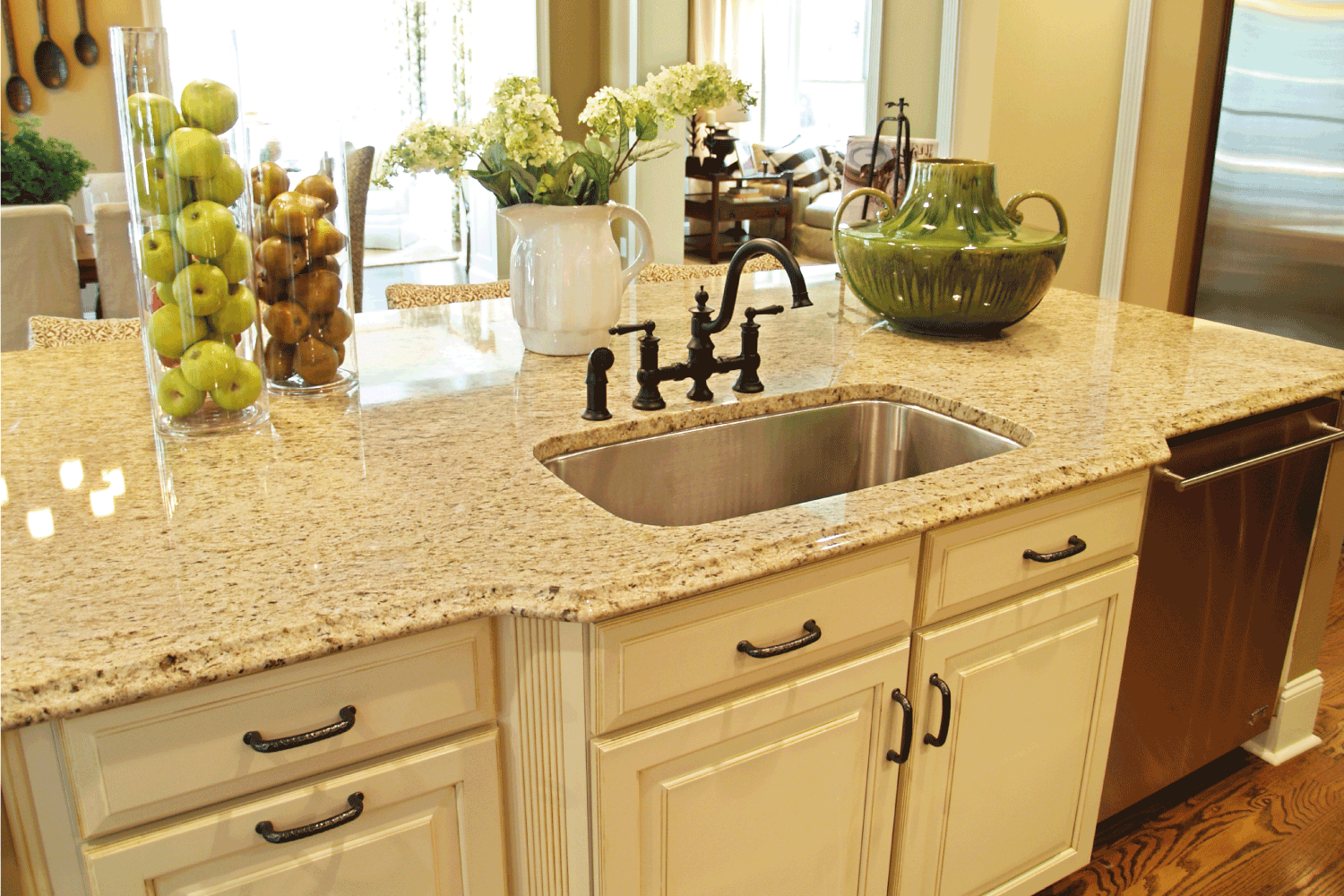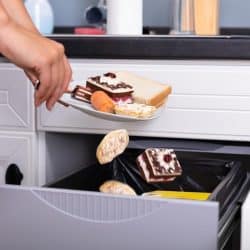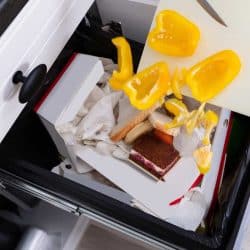Is your trash compactor making noise when it's in use? Or perhaps it's taking way too long to complete a cycle than it normally would. You may not realize this, but humidity in your kitchen and home, in general, can cause the components inside a trash compactor to become drier than normal--resulting in squeaky parts. So, we've researched how to lubricate your compactor to get rid of this issue. In this post, we'll discuss it.
Here are the steps to lubricate a trash compactor:
- Remove the drawer
- Unplug the appliance
- Clean the components
- Apply lubricant
- Replace the parts
- Plug in the compactor and test it
A home trash compactor may require a bit of lubrication every so often. Continue reading to learn how to detect when it may need lubrication and how to troubleshoot other common issues that may arise.

Steps to Lubricate A Trash Compactor
Things you'll need:
- Lubricant
- An applicator brush or 1-inch paintbrush
- Rubber gloves
- Disposable toothbrush
- Screwdriver

1. Remove the drawer
Disconnect the power source from the compactor. Remove the entire drawer assembly from the compactor. To do this, you'll need to slide the assembly forward while holding it by its sides.
2. Unplug the appliance
Take out the power cord and then lay the unit on its back. Use your screwdriver to remove the panel from the bottom. That'll give you direct access to the drive gear and chain.
There are usually two to three bolts holding the drive nut in place. Unscrew them and grab the driveshaft and nut.
Read more details about the screwdriver on Amazon.
3. Clean the components
Take your applicator brush and gently go over the bolts, shaft, and chain. Check the retainer for any debris and remove it with your hand. If helpful, take a damp rag and go over all of the parts to eliminate any sticky residue or impacted gunk that may be tough to remove.
4. Apply lubricant
Once you've thoroughly cleaned all the parts, take your lubricant and apply it to the gears and the chain. Next, take a small amount and apply it to the driveshaft, nuts, and retainer.
This is also a good time to do a quick inspection of the inner workings of the compactor to check for any damage, worn, or melted parts. In addition to this, it can be helpful to give the inside walls and floor of the compactor a quick cleaning with a damp towel and a bit of all-purpose cleaner.
Check out this lubricant on Amazon.
5. Replace the parts
After you have lubed the parts and wiped down the unit, replace all of the parts and screw them back into place.
6. Plug in the compactor and test it
Next, set the unit back upright and plug it in at the power cord. Next, fill the compactor halfway with trash and then run a test to ensure that it's working properly and all the parts are functioning. If you still notice any loud sound or the compactor does not work, look to your user manual to troubleshoot the issue.
How do you test a trash compactor motor?
To test your compactor's motor, you'll need to purchase a device called a multimeter. The multimeter can be used to check for continuity with the motor winding and centrifugal switch. The centrifugal switch allows the motor to turn, and if it's bad, the compactor will not work.
The motor winding is a row of conductive wires that are wrapped around a magnetic core. The wires allow electricity to flow to the motor enabling it to spin. If these wires become worn or melt, the motor won't run.
Read more details about his multimeter Amazon.
What should you not put in a trash compactor?
Some items that can be very hazardous if placed inside of your trash compactor include flammable liquids, glass, bent metal pieces, or other sharp objects that can cause bodily injury. Keep in mind that the trash compactor bags are only so thick. And if sharp objects pierce them, you can injure yourself when you change and replace the bag.
How do you troubleshoot a trash compactor?
There are a few common issues that trash compactors are known to have. However, the good thing is that most of them can typically be solved without hiring an appliance technician. You can do most of these troubleshooting methods on your own.
The unit won't power on
If you flip the switch on your compactor and it won't power on, there may be a small issue with the power. Before doing anything, check the power cord and make sure it's plugged into the wall completely. It's also helpful to test another appliance in the same plug to ensure that it is functioning properly.
If this isn't the issue, try resetting the compactor by following the user's guide. If that doesn't work, the drawer safety switch or the drive motor could be the issue. And if either is defective, they'll need to be replaced.
It is no longer compacting the trash
Sometimes a trash compactor will fail to compact trash properly. If you notice this issue with your compactor, start by removing the appliance from the wall and turning it on its side. Take off the bottom panel and have a look at the drive gear and belt.
Note that the belt or chain, depending on your make and model, should be tight with a decent amount of tension. If it isn't, tighten it manually. If the belt has broken, it'll need to be replaced.
The ram is stuck
This is probably the most common occurrence in trash compactors. If your compactor ram is stuck in the down position, remove the compactor from the wall and open up the bottom panel. The first things that you'll want to check are the directional switch and the drive gear. Make sure that the chain or belt on the drive gear has a sufficient amount of tension.
Remember that it shouldn't be too wobbly, and it should have no more than about 1/2-inch of deflection. This means that if you pull the chain or belt up with your finger, it should move no farther than half an inch.
Next, try to manually raise the ram using your hand. While it's in the up position, inspect the power nuts for any signs of corrosion or damage. Replace them if needed. If everything looks okay, check the directional switch terminals using a multimeter. If the terminals show no continuity, you'll need a replacement switch.
The compactor is making loud noises when in use
Starting to notice loud sounds coming from your compactor when it's in use? More often than not, this is an issue with dryness within the inner belt of the compactor. To fix the issue, remove the compactor from the wall and sit it on its side.
Next, remove the bottom panel to gain access to the drive belt. Take wheel bearing lubricant or another lubricant for parts and apply it to the drive shafts and chain. If there are any bearings or washers that appear to have dried out, it's best to lubricate these as well. Use a rag or a 1-inch paintbrush to apply the lubricant.
Check out this paintbrush on Amazon.
The unit is starting to emit foul odors
This is also a common issue with trash compactors. However, it's a relatively easy one to fix. If your compactor is giving off foul odors, you'll likely need to simply replace the bag. However, if the odor remains after doing so, it typically means that the interior of the compactor needs to be cleaned and sanitized. To do this, disconnect the power source and open up the compactor to remove the drawer.
Next, take a cleaning rag and an all-purpose cleaning solution and clean the compactor's walls, floor, and drawer. It's also a good idea to sprinkle a few teaspoons of baking soda on the interior floor to help absorb future odors. You'll need to replace it every couple of weeks, but it can definitely help get rid of this issue.
Why don't we use trash compactors anymore?
Many consumers simply didn't find enough need for a compactor. Keep in mind that trash compactor bags are more expensive than regular trash bags. Also, the units can be challenging to empty, and they can cause you to face increased costs for garbage disposal due to the weight of the compacted garbage.
Lastly, these appliances require electricity to function, and many consumers found that it's simply not worth the benefit for the cost and space they require.
Wrapping Things Up
Though trash compactors are not as popular as they used to be, they can still be useful appliances when reducing trash loads. If you find that your compactor is malfunctioning or making loud sounds, it may need lubrication. And if that doesn't work, it's best to troubleshoot the unit using your user's manual.
Check out some of our other posts before you go:
How To Adjust Kitchen Drawer Fronts






![A woman throwing away sliced peppers in to the trash compactor, Do Trash Compactors Need Special Bags? [And How To Measure For Them]](https://kitchenseer.com/wp-content/uploads/2021/08/A-woman-throwing-away-sliced-peppers-in-to-the-trash-compactor-1-250x250.jpg)



